Where to eat and drink in Rome
When I recently visited Rome, I spent most of my mornings following in Robert Langdon’s footsteps and visiting notable churches around the city. In the afternoon, I slowed down. I would first have a coffee, then a light lunch (followed by yet another coffee), whereas in the evening I had an aperitivo (a pre-meal drink) followed by dinner and gelato to end the day on a high note. Here are my recommendations about where to eat and drink in Rome:
Breakfast
Although I mostly had breakfast at the hotel where I stayed, I also had to try the maritozzi (cream-filled buns that Romans have for breakfast).
The Pasticceria Regoli (on Via dello Statuto) is renowned for its maritozzi. It is close to the Piazza and the Basilica di Santa Maria Maggiore (on the summit of the Esquiline Hill). Dating to the 5th century, this is one of the first churches built in honour of the Virgin Mary. Together with the Basilica di San Giovanni in Laterano, the Basilica di San Pietro and the Basilica di San Paolo fuori le Mura (St Paul Outside the Walls), it is one of the four major papal basilicas.
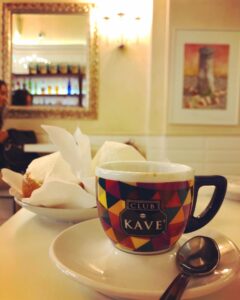
Another place famous for its maritozzi is the Bar San Calisto, in Trastevere, opposite the Chiesa di San Calisto. I went there rather late for maritozzi, so I just had coffee instead.
Brunch and coffee
Caffe Doria is a great place for brunch (or just a coffee) and can be accessed directly from Via della Gatta (parallel to Via del Corso). It is located in the Palazzo Doria Pamphilj, not to be confused with the Palazzo Pamphilj at the nearby Piazza di Navona. The Galleria of the same name (on the first floor of the Palazzo) features works by Michelangelo, Bernini, Raphael, Velasquez and many more (14 euros pp).
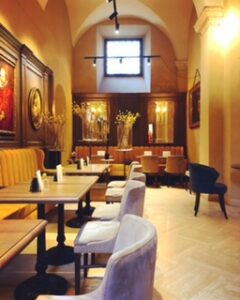
Not far from the Pantheon, there’s the Caffe Sant’Eustachio. Perhaps not the best choice on a rainy day, as there’s only outdoor seating. Opposite the caffe, the basilica of the same name was being restored at the time of my (last) visit.
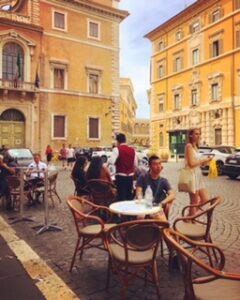
At the southern end of Piazza Navona, there’s the Fontana del Moro, the Chiesa di Nostra Signora del Sacro Cuore and the Museo di Roma. The latter is housed in the Palazzo Braschi and so does Vivi, a cafe overlooking Piazza Navona. Like most Rome museums, the Museo di Roma is closed on Mondays. The museum collection features paintings and photographs.
Not far from there, there’s the Chiostro del Bramante and the adjoining Chiesa di Santa Maria della Pace (on Via Arco della Pace). The former is an art museum and has a bellissima caffeteria that was sadly closed at the time of my visit.
Near Piazza di Spagna and the Spanish Steps, there’s Antico Caffe Greco (on Via dei Condotti). Although it’s rather expensive, it is a Rome institution and therefore well worth a pitstop. It has been there since 1760 for that matter.
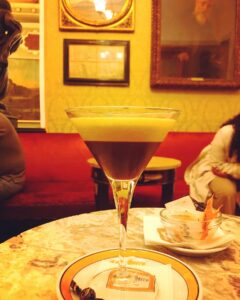
Near Campo de Fiori, there’s the Sicilian pasticceria I Dolci di Nonna Vicenza (on Via dei Pettinari).
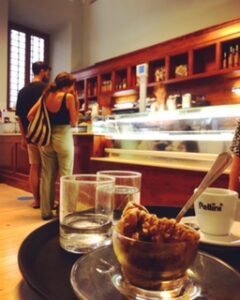
Lunch
If it’s time for lunch, I would recommend Pan Bernardo (at the Piazza San Bernando) or Pasticceria Dagnino (in an arcade that you can enter from Via Torino, just a minute away from the Piazza San Bernando).
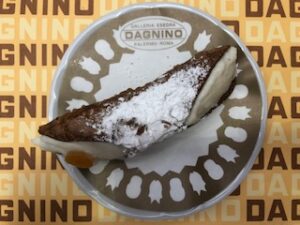
The former is opposite the Chiesa di Santa Maria della Vittoria, where Robert Langdon and Vittoria Vietra found the third assassinated cardinal, burning suspended from the ceiling on cables meant for lanterns. The highlight of the church is Bernini’s Santa Teresa trafitta dall’ amore di Dio.
The latter is halfway between the Chiesa di Santa Maria della Vittoria and the 16th-century Basilica di Santa Maria degli Angeli e dei Martiri, built inside the ruined frigidarium of the Terme di Diocleziano (the Baths of Diocletian). The basilica’s design was by Michelangelo.
Alternatively, you can head to MadeITerraneo, the rooftop restaurant of Rinascente, the department store on Via del Tritone. Here you can have a meal (or even a coffee or an aperitivo) against the backdrop of the Basilica di Sant’ Andrea delle Fratte.
Aperitivo
For an aperitivo (or even lunch for that matter), I would recommend the chiostro (cloister) of the Palazzo Doria Pamphilj.
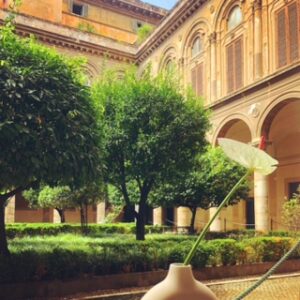
For a panoramic view of Rome’s historical centre, go to Bio Hotel Raphael. The rooftop terrace is a perfect place for an aperitivo.
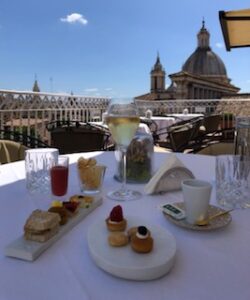
If you happen to be near Piazza del Popolo in the evening, the courtyard of the Stravinskij Bar at the Hotel de Russie (on Via del Babuino) is a beautiful place for an aperitivo, but you will need a reservation to get seated there, as well as dry weather. Sadly, my reservation got cancelled because of the rain.
I went to the Enoteca Buccone (on Via di Ripetta) instead, a perfect place to taste Italian wines.
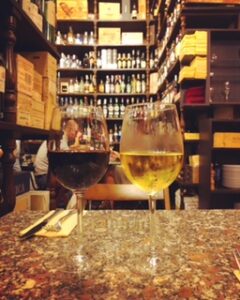
Dinner
Right next to the Pantheon, there’s Armando al Pantheon, a trattoria-institution (you will probably need a reservation to dine there). Stanley Tucci and I had rigatoni all’amatriciana (one of the four classic Roman pasta dishes) there.
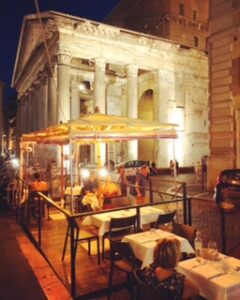
Other nearby options are Alfredo all Scrofa, the birthplace of the fettuccine Alfredo, made of fettuccine tossed with butter and parmesan.
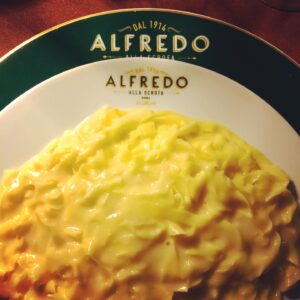
Not far from there, opposite the Chiesa di Sant’Ivo dei Bretoni, there’s La Campana, the oldest restaurant in Rome.
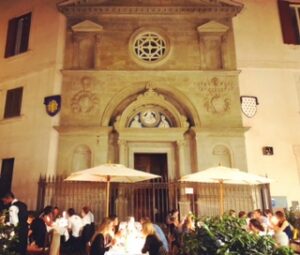
La Grande Bellezza, one of my favourite restaurants in Rome, is about 5-minutes away from the Chiesa di Santa Maria della Vittoria (on Via Flavia). In fact, when I last visited Rome, I had dinner there twice.
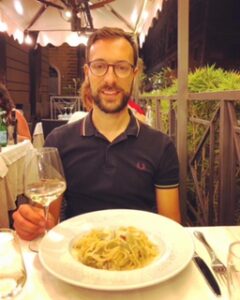
I also had dinner at Sora Margerita, a kosher trattoria next to the Chiesa di Santa Maria del Pianto, in the Piazza delle Cinque Scole in the Jewish Ghetto.
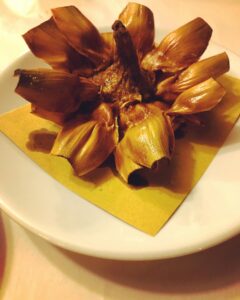
I would also recommend the Del Frate, a 100-year-old enoteca on Via degli Scipioni.
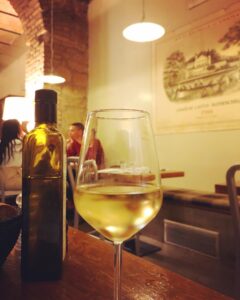
Perhaps now is the time to mention the four traditional Roman pasta dishes. These are:
- Alla Gricia, made with pasta (usually rigatoni), guanciale (an Italian cured meat product prepared from pork jowl or cheeks), pecorino (a hard, salty Italian cheese, often used for grating, made with sheep’s milk) and black pepper.
- Amatriciana, made with pasta (usually bucatini) and a sauce, made up of tomatoes, as well as guanciale, pecorino and onions.
- Cacio e pepe (cheese and pepper), made with pasta (spaghetti, bucatini or tonnarelli), pecorino and black pepper.
- Carbonara, made with pasta (spaghetti, fettuccine, rigatoni or bucatini), guanciale, cheese (pecorino or parmesan, or a combination of the two) and egg yolks.
Gelato
For gelato, there’s Giolitti, on Via degli Uffici del Vicario.
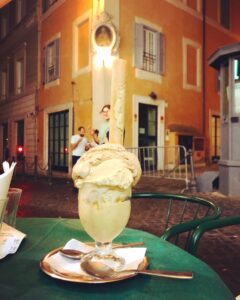
Alternatively, you can have a tartufo, a ball-shaped gelato-based dessert, at Tre Scalini in Piazza Navona.
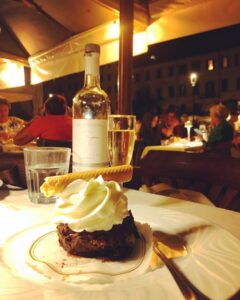
Further reading
To better prepare for my trip in Rome, I used the Lonely Planet Italy Travel Guide.
If you’ve worked out an appetite for Italy, check out my 10-day trip to Southern Italy. After landing in Bari, the capital and the largest city of Puglia, I visited the inland towns of Alberobello and Locorotondo, as well as the seaside Monopoli and Polignano a Mare. I then visited Matera, a city located not in Puglia, but in the neighbouring region of Basilicata. After staying there for a couple of days, I took the bus to Lecce and returned to Puglia. From there, I continued to Ostuni, Cisternino and Brindisi.
Alex
(the Traveling Psychiatrist)
One Comment
Pingback: